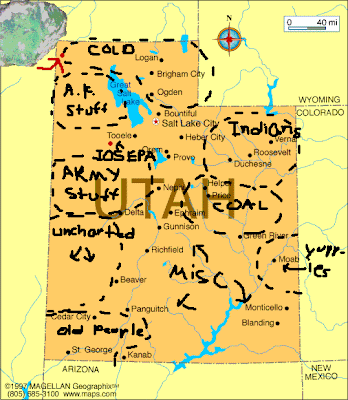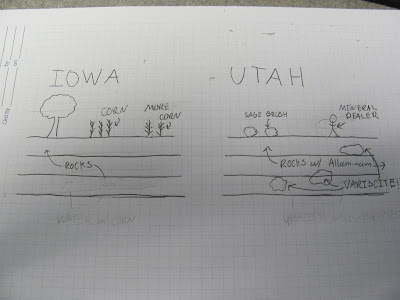Anyway, forget everything you've ever known about anything, because things are about to get really existential in here. Today we visit the world of the phosphorus-bearing minerals. Now, there is bound to be a lot of resistance to this, and I can honestly understand why. I mean, it's not every day that someone comes up to you and says "Hey, I have a great idea, let's delve into the world of some crazy hydrous, alluminium-bearing phosphate mineral with a hardness of 4.5!" Of course, your first reaction will be to tell me to go back to whatever nerd-hut I've escaped from. Well, don't worry, I'm not going to get too out of bounds with this post, although it would be quite easy (and quite tempting) to do so.
Today's mineral is a playful, unassuming little feller named Variscite....


Here's what it looks like if you take a picture of it too closely with the flash on....

Anyway, go ahead and bask in the glory of that poorly-photographed mineral! Allow it to change your perceptions of geology! Like many, many other minerals we've looked at, Variscite is green (most of the time). My friends, this is just the beginning. Put those burritos back in the microwave, because I'm serving up a heaping pot of mineralological what-the-devil-is-going-on pie and cramming it down your throats!
As I said above, the Variscite is the green portions of that rock. I'm not sure what the white stuff is, and don't really care. I'm guessing you don't either. Let's look at some more pictures of the stuff so we can get a better handle on what is going on here....

Not too impressive. Just sort of a greenish-blob. But what if IT WERE ATTACKED BY INDIANA JONES IN AN AIRPLANE???

And also....A NAZI!!!

As long as I've already destroyed any sense of personal worth by revealing that not only have I purchased Lego toys but that I also enjoy playing with them, we might as well push it to the limit! Look out Indy!

Vrooom!!! Bang Bang Bang!!

Look at that! That Nazi is flying into my ceiling fan!!!

The Nazi crashed! USA! USA!

Dooo do do dooooooooo!!!


It is pretty hard to fly two Lego planes by using your roommates dog leashes and take pictures of it at the same time. So if that makes that last part any less stupid to you then so be it. Either way, it serves as good filler for an otherwise info-light post.
As I mentioned earlier, Variscite has a hardness of 4.5. This places it squarely between scratching it with an iron nail and with a steel knife. So, yeah, there's some information for you hardness weirdos out there.
Chemically, Variscite is made of one atom of aluminum, one atom of phosphorus, four atoms of oxygen, and then a couple of water molecules for a final chemical formula of ALPO4*H2O. If we mix a little math into this, we come up with a whopping 17.8% aluminum, 19.2% phosphorus, 60.76% oxygen and whatever is left gets stuffed full of hydrogen. That 60.76% oxygen seems weird to me, but I'm not here to criticize geology. Anyway, you mix those things together and you get a slightly green mineral....THAT IS BLOWING UP THE BERLIN WALL!!!


Nah, that's just more filler. What you get is a mineral that is slightly green, but isn't really capable of righting any of the worlds ills. But Vaiscite isn't always green. Like most minerals it shows up in a variety of colors. Well, mostly just green and red....

I've never seen any red Variscite, but I suppose it's possible. Also it is pretty rare that it shows up in crystals. Mostly the stuff sticks with massive blobs (called nodules) that are various shades of green....


Those are pieces from a place named Clay Canyon in Utah. Remember how I said that Variscite is somewhat obscure? Well, that's because it is also pretty rare. In fact, the state of Utah is pretty much the main producer of the stuff. It was for this reason (I'm suspecting) that it also goes by the name Utahlite. The material from Clay Canyon is pricey because the mine that used to be there was shut down when the State of Utah discovered that the gentleman mining it was somewhat lax when it came to safety, and would frequently light sticks of dynamite outside of the mine, run in, place the explosive in the hole and try to run back out again before getting variscite-ed. As a result, the mine was collapsed so the dude wouldn't kill himself, which tends to drive prices up for the existing material. I went there once and poked around the mine dump but I got a bunch of sap on my shoe and decided to leave. The other main place to get Variscite is located in one of the oft-forgotten corner of the state....

Not a lot of people find their way out to that part of Utah. And probably for good reason, as it has more crazies per square mile than most areas of the state. That area produces Variscite that has less cool shapes and patterns and is more just solid green. The piece from the first picture is from that corner of the state, so you can go look at that again if you are having a hard time picturing it. The nearest town to that particular deposit is Lucin, Utah (which is now a ghost town), and it was for this name that Variscite was also known as Lucinite. That's three names for the same mineral! That should help keep the confusion down.
So there we are. Variscite comes from Utah (and a little from other places). So what is it good for? Well, again, like everything else we've looked at, not a whole lot. We can make pretty things to adorn our women with it....


Variscite sometimes takes the place of turquoise (which is basically variscite but with a little copper mixed in) but it is a little bit softer so it scratches easier. Hey, do you guys remember scratch and sniff books? Do they still make those? I'm going to have to investigate this later. Anyway, it can also be confused with Chrysocolla, (a copper mineral that is chemically nothing like either mineral) that kinda has the same color.

So how did Utah end up with so much of the stuff and poor Iowa is left out in the cold? Well, apparently Iowa didn't have enough phosphate-rich water flowing around its aluminum-rich rocks! Utah, on the other hand, had more phosphate-water than it knew what to do with, and it was this water that reacted with the native limestone that contained some aluminum for some reason. Let's look at what I've just said in a much more confusing way....



Did that clear it up? Nah, it didn't for me either. Fun to draw though.
For you metaphysical types, it is said that Variscite can help you remember your past lives! That's a heck of a thing! So if you pick up a piece of Variscite and suddenly remember getting your bowels torn out for believing that the earth wasn't the center of the universe, that's why. Hey, if you aren't prepared to suddenly remember being racked with torment, then perhaps you aren't prepared to be a geologist.
And so we end our first phosphorus-bearing mineral. The phosphates (as minerals with phosphorus are called) are an interesting bunch, so perhaps we will see them again. You can never tell with geology.
5 comments:
That was an amazing post. AMAZING and EMENET!
Your blog on this is hilarious. I went out to the Lucin mine and nabbed a few buckets of the stuff. I'm going to start polishing it and making paper weights.
You two are much too kind. You would be surprised about how hard it is to write a blog post about Variscite.
This is the most entertaining post on minerals I have ever read. (And no this is not the first post I have ever read.)
Great job making me laugh and learn at same time!
You are an amazing teacher!! I will always remember veriscite!! LMAO
Post a Comment